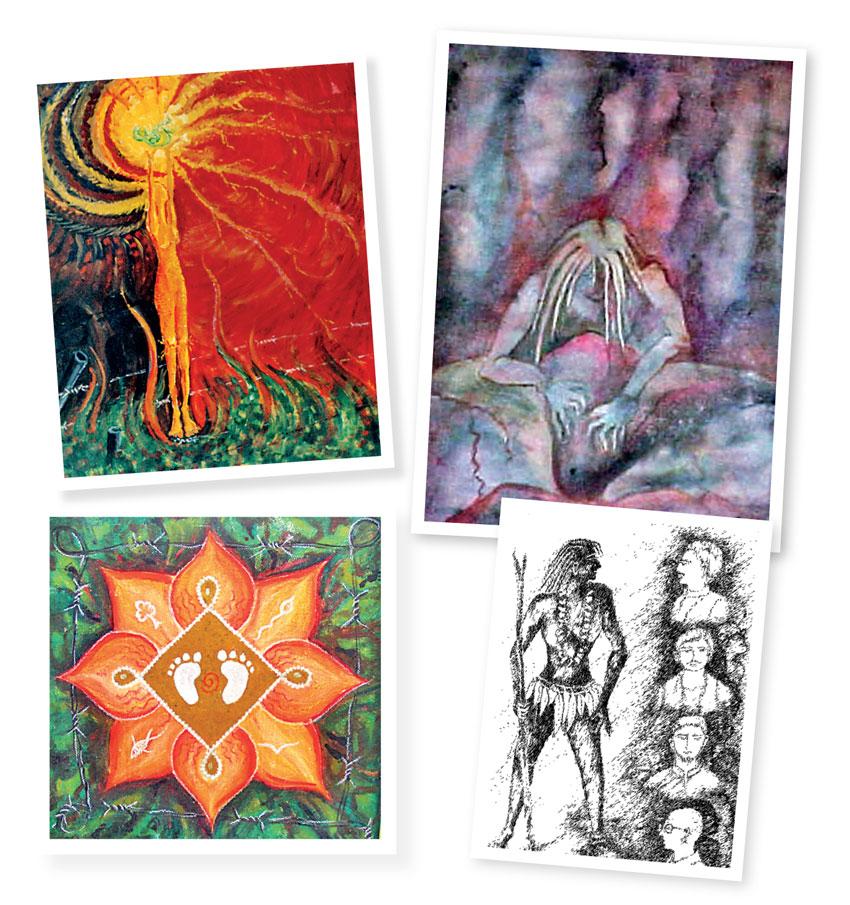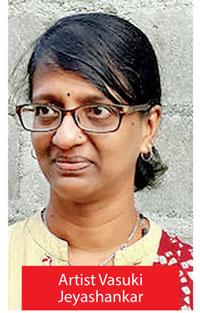30 Mar 2023 - {{hitsCtrl.values.hits}}

Kamala Vasuki (Born 1966) hails from Jaffna, Sri Lanka. Trained by A. Mark, a pioneering artist and art teacher who popularised modern art practices in northern Sri Lanka, she is among the few female visual artists from Sri Lanka in general and specifically from the north and east of Sri Lanka.
 Having had her first solo exhibition in 1989 in Jaffna, she is the only female visual artist who has sustained an art practice while continuing to live through the war. She has lived through the trials and tribulations of war, shelling, the danger of sexual violence, displacement, loss of loved ones and all the other profound disruptions of ordinary life. She moved to Batticaloa in 1995 and has been an integral part of women’s activist spaces for peace, non-violence and justice.
Having had her first solo exhibition in 1989 in Jaffna, she is the only female visual artist who has sustained an art practice while continuing to live through the war. She has lived through the trials and tribulations of war, shelling, the danger of sexual violence, displacement, loss of loved ones and all the other profound disruptions of ordinary life. She moved to Batticaloa in 1995 and has been an integral part of women’s activist spaces for peace, non-violence and justice.
She experienced growing up as a young woman as a student at Vembadi Girls High School, the University of Jaffna and later as a youth volunteer in myriad progressive groups in Jaffna and Colombo.
Vasuki’s artistic technique is vibrant and has changed over time. When looked at together it is possible to trace journeys through technique, style and colour palette in her work. This can be artistically interpreted as reflexive of the context in which she was making art and there remains validity and truth to that interpretation. When asked about these choices, Vasuki simply says
“I made art with whatever material I had access to”.
In the context of war when art materials were close to impossible to obtain, Vasuki worked with any paper, colours or other material she could find. She made sculptures out of plastic pens and soap. The soap sculptures were eventually used by those in her household when soap was no longer available in Jaffna due to the war-related embargo.
She drew on any paper she could find and hungrily grabbed any material she found and learned to make art with it, with enormous encouragement of this mode of art-making from her teacher and mentor who she and others lovingly refer to as Mark Master.
Now, looked at together, Vasuki’s art consists of landscape art, sketches, wash drawings, pastel paintings, cartoons and installations.
Her collective artwork, often with communities of women from different parts of the island often takes materials from the everyday lives of women such as fabric, saris, objects, flowers, grains etc. to tell their own stories.
Vasuki has had individual and group exhibitions in different parts of Sri Lanka and abroad, including Nepal, Australia and the Netherlands.
In what is perhaps a fitting testament to her place in the world of visual art in Sri Lanka, her work was displayed and printed along with that of only nine other artists from the island in the book ‘A to Z of Conflict’, a trilingual collection of conflict-related words displayed around artistic works published by Raking Leaves in 2019.
As a collection of specially commissioned works, it is one of the largest artistic works on conflict to emerge from the island.
Vasuki’s art practice is deeply grounded in her life experiences and her feminist perspective on the world. Now almost 35 years later since she began making art, her work bears witness to the histories she has lived through.
Some of her paintings such as the painting related to the rape and murder of Krishanthi Kumaraswamy in 1996 and the ‘My child is not for war’ painting have become iconic symbols of histories of the war, especially from a feminist and women’s perspective.
More recently her paintings are being used as a pedagogic tool to teach the histories of the past 30 years, including that of the war in Sri Lanka. As much as Vasuki’s work is an archive and a way to know, understand and feel the history of the north and east of Sri Lanka for the past four decades, she continues to be an artistic witness and commentator in contemporary Sri Lanka.
She has created work, that is a response to contemporary realities such as the pandemic, the economic crisis, and ongoing struggles for social change and justice.
One of the most important aspects of her continuing work is her collective art-making practice where she creates space for women, often from marginalized backgrounds who have been deeply impacted by war, poverty and other forms of injustice to create art together.
A retrospective of Vasuki’s work goes beyond an individual history of a single artist. To the contrary, this retrospective, just as with her art, bears witness to four decades of history of this island, of the ordinary people of this land, the violent plight they continue to endure and the consistent histories of resistance and demands for justice.
Simultaneously the simple and sheer beauty of this land and its people peeps through in Vasuki’s strokes and colours providing a holistic and nuanced history that is made possible through art.
The exhibition titled Kamala Vasuki: A Retrospective (1989 -2023), will take place on April 5- April 10 between 9.00 a.m to 5.00 p.m at 55, Lady Manning Drive, Batticaloa, Sri Lanka. The exhibition traces the artistic journey of a woman-artist from the north and east of Sri Lanka. Through multiple media, individual and collective art, her work bears witness to the scarred histories of pain, hope and healing of her island home over the past thirty years. Contact Nos: Jeya: 0778095587 Sarala: 0773134065
10 Jan 2025 23 minute ago
10 Jan 2025 1 hours ago
10 Jan 2025 3 hours ago
10 Jan 2025 3 hours ago
10 Jan 2025 5 hours ago